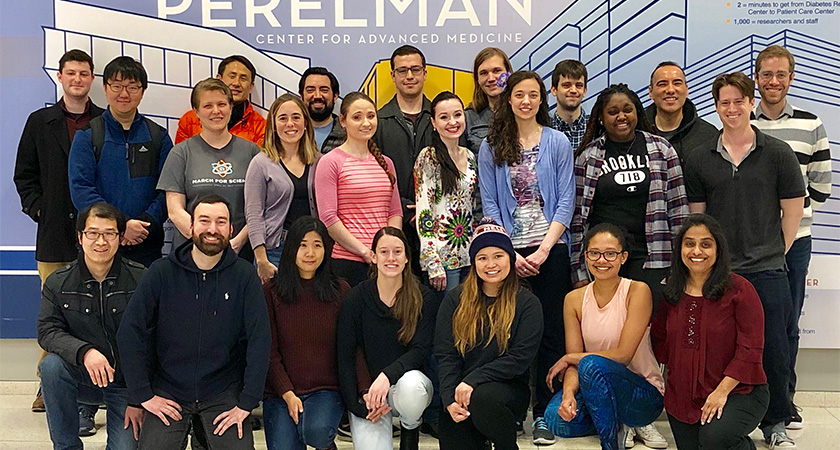
Benjamin Garcia, Ph.D., FRSC
The Perelman School of Medicine at the University of Pennsylvania
Penn Epigenetics Institute
Department of Biochemistry and Biophysics
Smilow Center for Translational Research
Room 9-124 (office)
Room 9-175C (Lab)
3400 Civic Center Blvd, Bldg 421
Philadelphia, PA 19104-5157
Office: 215-573-9423

Research Interest
The Garcia lab is interested in the development and application of quantitative mass spectrometry based proteomics for understanding dynamic proteome and protein post-translational modifications. In particular, we are interested in understanding combinatorial histone PTMs and their role in regulating gene expression.
Contribution to Science
Work in my lab focuses on development of advanced methodology for Bottom Up MS analysis of histones that has revealed several novel facets of epigenetic histone biology. These approaches have improved the quantification and high-throughput analyses of histone PTMs, and have allowed for novel histone PTM sites to be uncovered. More recently, my lab has developed data independent approaches to enhance quantification of histone PTMs using SWATH experiments on a TripleTOF instrument and found these approaches to be superior to standard proteomics experiments. We have also recently shown that very good characterization and quantification of histones can be performed on a lower resolution instrument such as an ion trap. Recently, the construction of a heavy labeled synthetic histone PTM modified library was achieved and used to define ionization efficiency discrepancies and to determine correction factors for absolute quantification. On the computational side, my lab has created several algorithms for histone PTM detection and quantification that are freely available to the proteomics community as well. All of these advances have been employed to identify several epigenetic targets involved in processes such as cancer, viral infection and cellular reprogramming.
- Lin S, Garcia BA. Examining histone posttranslational modification patterns by high-resolution mass spectrometry.Methods in enzymology. 2012;512:3-28. PMC4116684.
- Leroy G, Dimaggio PA, Chan EY, Zee BM, Blanco MA, Bryant B, Flaniken IZ, Liu S, Kang Y, Trojer P, Garcia BA. A quantitative atlas of histone modification signatures from human cancer cells.Epigenetics & chromatin. 2013;6(1):20. PMC3710262.
- Sridharan R, Gonzales-Cope M, Chronis C, Bonora G, McKee R, Huang C, Mishra, N., Garcia, B.A.*, Plath, K.* Proteomic and genomic approaches reveal critical functions of H3K9 methylation and heterochromatin protein-1gamma in reprogramming to pluripotency.Nature cell biology. 2013;15(7):872-82. PMC3733997. *Co-corresponding authors
- Sidoli S, Lin S, Xiong L, Bhanu NV, Karch KR, Johansen E, , Hunter C, Mollah S, Garcia BA. SWATH Analysis for Characterization and Quantification of Histone Post-translational Modifications.Molecular & cellular proteomics : MCP. 2015. PMID: 25636311.
Histone PTMs have been separately associated with either transcriptional activation or repression depending on the location of a single PTM site, but what type of effect distinct combinations of simultaneously occurring PTMs (Histone Codes) have upon transcriptional events remains unclear. The Garcia lab has addressed this problem by developing novel Middle Down MS based methods for high-throughput quantitative tracking of hundreds of combinatorial Histone Codes in a single experiment. These new methods based on HILIC chromatography and electron transfer dissociation (ETD) were the first of their type for high-throughput proteomic sequencing of combinatorial Histone Codes, and this publication was listed as a Faculty of 1000 Biology must read article (http://f1000biology.com/article/id/1164285/evaluation) as well. To date they have performed experiments on human histones and have discovered over 600 distinctly modified Histone Codes on histone H3. This represents a vast increase in previously identified histone modified forms compared to the previous method (also developed by Garcia as a postdoc with Neil Kelleher). This method is arguably the most sensitive in the world for analyzing combinatorial histone PTM patterns to date. Additionally, we have developed algorithms for the untargeted characterization of combinatorial PTMs and for assigning novel PTM sites on histones, as this data is the first of its type and cannot be analyzed by any commercially available software.
- DiMaggio PA, Jr., Young NL, Baliban RC, Garcia BA, Floudas CA. A mixed integer linear optimization framework for the identification and quantification of targeted post-translational modifications of highly modified proteins using multiplexed electron transfer dissociation tandem mass spectrometry.Molecular & cellular proteomics : MCP. 2009;8(11):2527-43. PMC2773719.
- Young NL, DiMaggio PA, Plazas-Mayorca MD, Baliban RC, Floudas CA, Garcia BA. High throughput characterization of combinatorial histone codes.Molecular & cellular proteomics : MCP. 2009;8(10):2266-84. PMC2758755.
- Molden RC, Garcia BA. Middle-Down and Top-Down Mass Spectrometric Analysis of Co-occurring Histone Modifications.Current protocols in protein science / editorial board, John E Coligan [et al]. 2014;77:23 71-78. PMC4160057.
- Sidoli S, Lin S, Karch KR, Garcia BA. Bottom-up and middle-down proteomics have comparable accuracies in defining histone post-translational modification relative abundance and stoichiometry.Analytical chemistry. 2015;87(6):3129-33. PMID: 25719549.
Although histone PTMs such as acetylation are known to be dynamically reversible processes, most studies only present a static snapshot of histone PTMs. To follow dynamic histone PTM flux/kinetics, the Garcia lab has have created novel approaches using quantitative MS in combination with in vivo metabolic labeling of specific PTMs for temporal analysis of the Histone Code. Using these approaches, we can monitor the progression and dynamics of specific histone PTMs during their cellular lifespan including histone methylation, acetylation and phosphorylation. With these approaches, we have begun to define for the first time the steady-state turnover kinetics and half-lives of all known histone modification sites, finding interesting correlations with PTMs associated with active or silenced genes. For example, pulsing cells with isotopically heavy methionine will result in histone (and protein) methylation labeling, as methionine serves as the sole precursor to s-adenosyl methionine which is the sole source of protein methylation. They have defined the steady-state turnover kinetics and half-lives of all known histone H3 and H4 methylation sites, finding that methylation sites associated with active genes turnover much faster that those associated with silenced genes. These half-lives are surprisingly long (0.5 to 2 days) demonstrating that histone methylation is incredibly stable. Our lab also used this approach for distinction of old and new histones, and can allow for tracking of histone modification pattern formation across the cell cycle.
- Zee BM, Levin RS, Xu B, LeRoy G, Wingreen NS, Garcia BA. In vivo residue-specific histone methylation dynamics.The Journal of biological chemistry. 2010;285(5):3341-50. PMC2823435.
- Zee BM, Britton LM, Wolle D, Haberman DM, Garcia BA. Origins and formation of histone methylation across the human cell cycle.Molecular and cellular biology. 2012;32(13):2503-14. PMC3434498.
- Evertts AG, Zee BM, Dimaggio PA, Gonzales-Cope M, Coller HA, Garcia BA. Quantitative dynamics of the link between cellular metabolism and histone acetylation.The Journal of biological chemistry. 2013;288(17):12142-51. PMC3636898.
- Molden RC, Goya J, Khan Z, Garcia BA. Stable isotope labeling of phosphoproteins for large-scale phosphorylation rate determination.Molecular & cellular proteomics : MCP. 2014;13(4):1106-18. PMC3977188.
Lastly, the Garcia lab is also taking an active approach to characterize more specific regions of the genome with the goal of analyzing all the histone PTMs and non-histone proteins such as transcription factors that are found on individual genes. This work termed “proteogenomic mapping” for the characterization of local chromatin regions has proven vital for determining how histone PTMs and their interaction networks contribute to distinct transcriptional states, and represents the missing link between genomics based sequencing and quantitative MS based proteomics research to provide a proteomic snapshot of the chromosome landscape. This is based on utilizing a chromatin immunoprecipitation quantitative mass spectrometry approach (ChIP-qMS) to determine what the landscape of the local chromatin environment looks like, and genomics to map this proteomic data back to specific genomic loci. Using proteogenomic mapping, the Garcia lab has also started to define the make-up of single nucleosomes and whether they occur in symmetric or asymmetric forms (i.e. both H3 molecules modified with the exact PTM patterns or not). This is an open question whether both copies of a histone within a nucleosome carry identical PTMs in vivo that has not been addressed. We find that mononucleosomes purified from embryonic cells exhibit both symmetrically and asymmetrically modified populations with respect to H3K27me3. Analysis of histone mark co-occurrence by the same approach revealed novel relations between histone marks and provides direct physical evidence for the existence of bivalent nucleosomes carrying H3K4me3 or H3K36me3 along with H3K27me3, albeit on opposite H3 tails. These results uncover a mechanism for the establishment of nucleosomes with bivalent features.
- Leroy G, Chepelev I, Dimaggio PA, Blanco MA, Zee BM, Zhao K, Garcia, BA. Proteogenomic characterization and mapping of nucleosomes decoded by Brd and HP1 proteins.Genome biology. 2012;13(8):R68. PMC3491368.
- Voigt P, LeRoy G, Drury WJ, 3rd, Zee BM, Son J, Beck DB, Young NL, Garcia BA, Reinberg D. . Asymmetrically modified nucleosomes.Cell. 2012;151(1):181-93. PMC3498816.
- Wang CI, Alekseyenko AA, LeRoy G, Elia AE, Gorchakov AA, Britton LM, Elledge SJ, Kharchenko PV, Garcia BA, Kuroda MI. Chromatin proteins captured by ChIP-mass spectrometry are linked to dosage compensation in Drosophila.Nature structural & molecular biology. 2013;20(2):202-9. PMC3674866.
- Won KJ, Choi I, LeRoy G, Zee BM, Sidoli S, Gonzales-Cope M Garcia BA. Proteogenomics analysis reveals specific genomic orientations of distal regulatory regions composed by non-canonical histone variants.Epigenetics & chromatin. 2015;8:13. PMC4397702.
Lab Members
| FIRST NAME: | LAST NAME: | TITLE: | EMAIL: |
|---|---|---|---|
| Benjamin | Garcia | PI | bgarci@pennmedicine.upenn.edu |
| Laura | Agosto | PhD Student, BMB | lauramagosto_01@hotmail.com |
| Laura | Agosto | PhD Student, BMB | lauramagosto_01@hotmail.com |
| Josue | Baeza | Postdoc | baeza@pennmedicine.upenn.edu |
| Natarajan | Bhanu | Lab Manager | nbhanu@pennmedicine.upenn.edu |
| Joe | Cesare | Research Specialist | cesare@pennmedicine.upenn.edu |
| Mariel | Coradin | PhD Student, BMB | mariel.coradin@gmail.com |
| Geoff | Dann | Postdoc | geoffrey.dann@pennmedicine.upenn.edu |
| Michael | Gilbert | PhD Student, BMB | Michael.Gilbert@pennmedicine.upenn.edu |
| Kevin | Janssen | PhD Student, BMB | kxjanssen@gmail.com |
| Hee Jong | Kim | PhD Student, BMB | heejong@heejong.com |
| Yekaterina | Kori | PhD Student, BMB | yekaterinakori@gmail.com (prefer) |
| Katarzyna (Kasia) | Kulej | Postdoc | Kulej.katarzyna@gmail.com |
| Richard | Lauman | PhD Student, BMB | rlauman@pennmedicine.upenn.edu |
| Hyoungjoo | Lee | Technical Director | hjlee@pennmedicine.upenn.edu |
| Abby | Lemmon | Research Specialist | abbylemmon96@gmail.com |
| Jen | Liddle | Postdoc | jc1liddle@gmail.com |
| Congcong | Lu | Postdoc | lu.congcong08@gmail.com |
| Peder | Lund | Postdoc | pederl@pennmedicine.upenn.edu |
| Mariel | Mendoza | PhD Student, BMB | marielgr@pennmedicine.upenn.edu |
| Stephanie | Miller | Postdoc | smlehman@pennmedicine.upenn.edu |
| Lindsay | Pino | Postdoc | lindsay.pino@gmail.com |
| Elizabeth (Libby) | Porter | Postdoc | libbyporter4@gmail.com |
| Janice | Reynaga | PhD Student, BMB | janice.reynaga@pennmedicine.upenn.edu |
| Neha | Srikumar | PhD Student, BMB | neha.srikumar@pennmedicine.upenn.edu |
| Amber | Weiner | PhD Student, GCB | amberkweiner@gmail.com (prefer) |
| Khadija | Wilson | PhD Student, PGG | khadijaw479@gmail.com |


